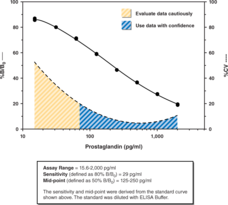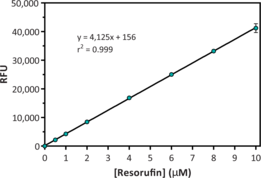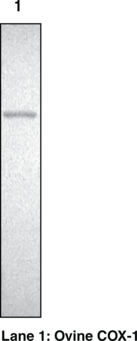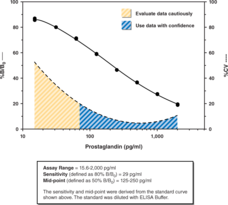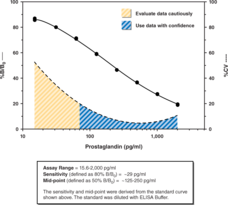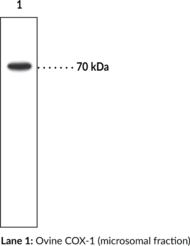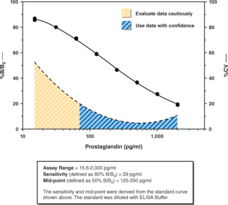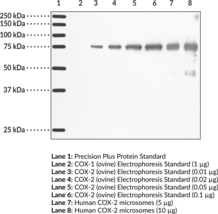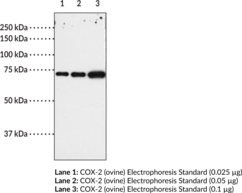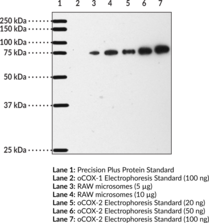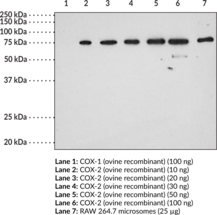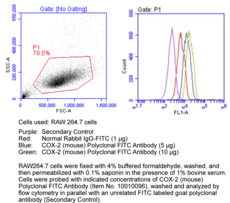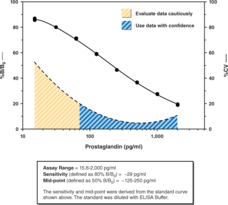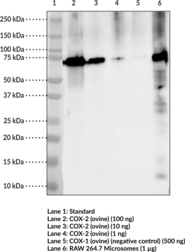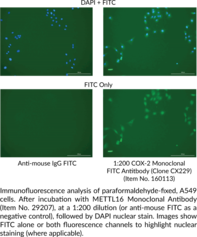Cayman
Showing 16201–16350 of 45550 results
-
Cyclooxygenase (COX, also called Prostaglandin H Synthase or PGHS) enzymes contain both cyclooxygenase and peroxidase activities. COX catalyzes the first step in the biosynthesis of prostaglandins (PGs), thromboxanes, and prostacyclins; the conversion of arachidonic acid to PGH2. It is now well established that there are two distinct isoforms of COX. Cyclooxygenase-1 (COX-1) is constitutively expressed in variety of cell types and is involved in normal cellular homeostasis. A variety of mitogenic stimuli such as phorbol esters, lipopolysaccharides, and cytokines lead to the induced expression of a second isoform of COX, cyclooxygenase-2 (COX-2). COX-2 is responsible for the biosynthesis of PGs under acute inflammatory conditions.{4} This inducible COX-2 is believed to be the target enzyme for the anti-inflammatory activity of nonsteroidal anti-inflammatory drugs. The COX (ovine/human) Inhibitor Screening Assay directly measures PGF2α produced by SnCl2 reduction of COX-derived PGH2. The prostanoid product is quantified via enzyme immunosorbent assay (ELISA) using a broadly specific antibody that binds to all the major prostaglandin compounds. Thus, the Cayman COX assay is more accurate and reliable than an assay based on peroxidase inhibition. The Cayman COX Inhibitor Screening Assay includes both ovine COX-1 and human recombinant COX-2 enzymes in order to screen isozyme-specific inhibitors. This assay is an excellent tool which can be used for general inhibitor screening, or to eliminate false positive leads generated by less specific methods.
Brand:CaymanSKU:560131 - 96 wellsAvailable on backorder
The COX Activity Assay utilizes the peroxidase component of cyclooxygenases. The peroxidase activity is assayed colorimetrically by monitoring the appearance of oxidized N,N,N’,N’-tetramethyl-p-phenylenediamine (TMPD) at 590 nm.{8581} The assay can be used to measure COX activity (COX-1 and COX-2) in cell lysates, tissue homogenates, and purified enzyme preparations. The assay includes COX-1 and COX-2 specific inhibitors in order to distinguish between the two isozymes.
Brand:CaymanSKU:760151 - 96 wellsAvailable on backorder
The COX Colorimetric Inhibitor Screening Assay measures the peroxidase component of cyclooxygenases. The peroxidase activity is assayed colorimetrically by monitoring the appearance of oxidized N,N,N’,N’-tetramethyl-p-phenylenediamine (TMPD) at 590 nm.{8581} Inhibition of COX activity, measured by TMPD oxidation, by a variety of selective and nonselective inhibitors, shows changed potencies similar to those observed with other in vitro methods. The COX Colorimetric Inhibitor Screening assay includes both ovine COX-1 and human recombinant COX-2 enzymes in order to screen isozyme-specific inhibitors. The Cayman COX Colorimetric Assay is a time saving tool for screening vast numbers of inhibitors.
Brand:CaymanSKU:701050 - 2 x 96 wellsAvailable on backorder
Cyclooxygenase (COX, also called Prostaglandin H Synthase or PGHS) is a bifunctional enzyme exhibiting both COX and peroxidase activities. The COX component converts arachidonic acid to a hydroperoxy endoperoxide (PGG2), and the peroxidase component reduces the endoperoxide to the corresponding alcohol (PGH2), the precursor of PGs, thromboxanes, and prostacyclins.{500,501} It is now well established that there are two distinct isoforms of COX, namely COX-1 and COX-2. Cayman’s COX Fluorescent Activity Assay provides a convenient fluorescence-based method for detecting COX-1 or COX-2 activity in both crude (cell lysates/tissue homogenates) and purified enzyme preparations. The assay utilizes the peroxidase component of COXs. In this assay, the reaction between PGG2 and ADHP (10-acetyl-3,7-dihydroxyphenoxazine) produces the highly fluorescent compound resorufin that can be analyzed using an excitation wavelength of 530-540 nm and an emission wavelength of 585-595 nm. The kit includes isozyme-specific inhibitors for distinguishing COX-2 activity from COX-1 activity.
Brand:CaymanSKU:700200 - 2 x 96 wellsAvailable on backorder
Cyclooxygenase (COX, also called Prostaglandin H Synthase or PGHS) is a bifunctional enzyme exhibiting both COX and peroxidase activities. The COX component converts arachidonic acid to a hydroperoxy endoperoxide (PGG2), and the peroxidase component reduces the endoperoxide to the corresponding alcohol (PGH2), the precursor of PGs, thromboxanes, and prostacyclins.{500,501} It is now well established that there are two distinct isoforms of COX, COX-1 and COX-2. Cayman’s COX Fluorescent Inhibitor Screening Assay provides a convenient fluorescence-based method for screening ovine COX-1 and human recombinant COX-2 for isozyme-specific inhibitors. The assay utilizes the peroxidase component of COXs. In this assay, the reaction between PGG2 and ADHP (10-acetyl-3,7-dihydroxyphenoxazine) produces the highly fluorescent compound resorufin. Resorufin fluorescence can be analyzed with an excitation wavelength of 530-540 nm and an emission wavelength of 585-595 nm.
Brand:CaymanSKU:700100 - 2 x 96 wellsAvailable on backorder
Brand:CaymanSKU:460103 - 1 eaAvailable on backorder
Brand:CaymanSKU:460102 - 1 eaAvailable on backorder
Brand:CaymanSKU:460106 - 1 eaAvailable on backorder
Brand:CaymanSKU:460105 - 1 eaAvailable on backorder
Brand:CaymanSKU:460104 - 1 eaAvailable on backorder
Brand:CaymanSKU:460107 - 1 eaAvailable on backorder
Immunogen: Purified sheep seminal vesicular COX-1 • Host: Rabbit • Species Reactivity: (+) Murine COX-1, sheep seminal vesicular COX-1, sheep placental COX-2 • Applications: WB
Brand:CaymanSKU:160103- 500 µlCyclooxygenase catalyzes the first step in the biosynthesis of prostaglandins, thromboxanes, and prostacyclins: the conversion of arachidonic acid to prostaglandin H2 COX-1 is constitutively expressed in almost all animal tissues and is involved in the homeostatic role of eicosanoids.{14,767} Recent discoveries of the induction of cyclooxygenase biosynthesis by a variety of stimuli such as phorbol esters, lipopolysaccharides, and cytokines led to the hypothesis that the inducible form of cyclooxygenase, COX-2, is responsible for the biosynthesis of prostaglandins under acute inflammatory conditions.{4} COX-1 and -2 are 70 and 72 kDa proteins, respectively. Both cyclooxygenases have been cloned from a variety of species including human, mouse, rat, and sheep.{13,4051} COX-1 isoform at the amino acid level, whereas the homology between COX-1 and COX-2 is only about 60%.
Brand:CaymanSKU:160103 - 500 µlAvailable on backorder
Immunogen: Purified sheep seminal vesicular COX-1 • Host: Rabbit • Species Reactivity: (+) Murine COX-1, sheep seminal vesicular COX-1, sheep placental COX-2 • Applications: WB
Brand:CaymanSKU:160103- 500 µlAvailable on backorder
Cyclooxygenase (COX, also called Prostaglandin H Synthase or PGHS) is a bifunctional enzyme that converts arachidonic acid to a hydroperoxy endoperoxide (PGG2) and reduces the endoperoxide to the corresponding alcohol (PGH2), the precursor of prostaglandins, thromboxanes, and prostacyclins. COX-1 is constitutively expressed in a variety of cell types and is involved in normal cellular homeostasis. The COX-1 (human) Inhibitor Screening Assay directly measures PGF2α by SnCl2 reduction of COX-derived PGH2 produced in the COX reaction. The prostanoid product is quantified via enzyme immunoassay using a broadly specific antiserum that binds to all the major prostaglandin compounds. This assay includes human recombinant COX-1 allowing the user to screen specific inhibitors. This assay is an excellent tool that can be used for general inhibitor screening, or to eliminate false positive leads generated by less specific methods.
Brand:CaymanSKU:701070 - 96 wellsAvailable on backorder
Immunogen: Peptide from the internal region of mouse COX-1 • Host: Rabbit • Species Reactivity: (+) Mouse and ovine; (-) Human; other species not tested • Cross Reactivity: (-) COX-2 (all species) • Application: WB
Brand:CaymanSKU:160109- 1 eaCOX-1 is responsible for the production of prostaglandins essential for the normal function of many organs including the stomach and kidney.{3463} COX-1 is generally described as being constitutively expressed, although COX-1 expression is regulated developmentally and in response to a variety of other stimuli.{6608,13,1508,12} Mouse COX-1 has a molecular weight of 70,000 and is expressed in nearly all tissues of the body.{3463,300}
Brand:CaymanSKU:160109 - 1 eaAvailable on backorder
Immunogen: Peptide from the internal region of mouse COX-1 • Host: Rabbit • Species Reactivity: (+) Mouse and ovine; (-) Human; other species not tested • Cross Reactivity: (-) COX-2 (all species) • Application: WB
Brand:CaymanSKU:160109- 1 eaAvailable on backorder
COX-1 and COX-2 catalyze the production of the prostaglandin (PG) and thromboxane precursor PGH2. COX-2 is primarily responsible for the biosynthesis of PGs under acute inflammatory conditions. The COX-1 (ovine) Inhibitor Screening Assay measures PGF2α that is produced by SnCl2 reduction of COX-1-derived PGH2. PGF2α is quantified via enzyme immunoassay (EIA) using a broadly specific antiserum that binds to all the major PG compounds. This assay includes ovine COX-1 and is an excellent tool which can be used for general inhibitor screening, or to eliminate false positive leads generated by less specific methods.
Brand:CaymanSKU:701090 - 96 wellsAvailable on backorder
Immunogen: purified ovine COX-1 • Host: mouse, clone CX111 • Isotype: IgG2b • Cross Reactivity: (+) human, bovine, mouse, ovine, and rat COX-1, ovine COX-2 (50%), and human COX-2 (~5%); (−) mouse COX-2 • Application(s): IHC and WB
Brand:CaymanSKU:160110- 1 eaCOX-1 is responsible for the production of prostaglandins essential for the normal function of many organs including stomach and kidney.{3463} Although COX-1 is generally described as constitutively expressed, this is actually an oversimplification. COX-1 expression is regulated developmentally and in response to a variety of other stimuli.{6608,13,1508,12} COX-1 has a molecular weight of 70 kDa and is expressed in nearly all tissues of the body.{3463,13,300,919}
Brand:CaymanSKU:160110 - 1 eaAvailable on backorder
Immunogen: purified ovine COX-1 • Host: mouse, clone CX111 • Isotype: IgG2b • Cross Reactivity: (+) human, bovine, mouse, ovine, and rat COX-1, ovine COX-2 (50%), and human COX-2 (~5%); (−) mouse COX-2 • Application(s): IHC and WB
Brand:CaymanSKU:160110- 1 eaAvailable on backorder
Immunogen: Purified ovine COX-1 • Clone designation: CX111 • Host: Mouse • Cross-Reactivity: (+) Ovine COX-2 (50%) • Species Reactivity: (+) Human, bovine, mouse, ovine, and rat • Application: FC
Brand:CaymanSKU:160111- 250 µgThis product is derived by labeling the COX-1 monoclonal antibody (Item No. 160110) with fluorescein. COX-1 catalyzes the first step in the biosynthesis of prostaglandins, thromboxanes, and prostacyclins: the conversion of arachidonic acid to prostaglandin H2. COX-1 is constitutively expressed in almost all animal tissues and is involved in the homeostatic role of eicosanoids.{14,767} COX-1 is a 70 kDa protein which has been cloned from a variety of species including human, mouse, rat, and sheep.{13,300,5695,919} COX-1 from these species are approximately 90% identical at the amino acid level, whereas the homology between COX-1 and COX-2 is only about 60%.
Brand:CaymanSKU:160111 - 250 µgAvailable on backorder
Immunogen: Purified ovine COX-1 • Clone designation: CX111 • Host: Mouse • Cross-Reactivity: (+) Ovine COX-2 (50%) • Species Reactivity: (+) Human, bovine, mouse, ovine, and rat • Application: FC
Brand:CaymanSKU:160111- 250 µgAvailable on backorder
Immunogen: Purified ovine COX-1 • Host: Mouse, clone CX111 • Cross Reactivity: (+) Ovine COX-2 (50%); (−) Mouse COX-2 • Species Reactivity: (+) Human, bovine, mouse, ovine, and rat • Application(s): FC and IF • Isotype: IgG2b • This product is derived by labeling the COX-1 monoclonal antibody (Item No. 160110) with phycoerythrin.
Brand:CaymanSKU:160120- 1 eaThis product is derived by labeling the COX-1 monoclonal antibody (Item No. 160110) with phycoerythrin. COX-1 is responsible for the production of prostaglandins essential for the normal function of many organs including stomach and kidney.{3463} Although COX-1 is generally described as constitutively expressed, this is actually an oversimplification. COX-1 expression is regulated developmentally and in response to a variety of other stimuli.{6608,13,1508,12} COX-1 has a molecular weight of 70,000 and is expressed in nearly all tissues of the body.{3463,13,300,919}
Brand:CaymanSKU:160120 - 1 eaAvailable on backorder
Immunogen: Purified ovine COX-1 • Host: Mouse, clone CX111 • Cross Reactivity: (+) Ovine COX-2 (50%); (−) Mouse COX-2 • Species Reactivity: (+) Human, bovine, mouse, ovine, and rat • Application(s): FC and IF • Isotype: IgG2b • This product is derived by labeling the COX-1 monoclonal antibody (Item No. 160110) with phycoerythrin.
Brand:CaymanSKU:160120- 1 eaAvailable on backorder
COX-1 and COX-2 catalyze the production of the prostaglandin (PG) and thromboxane precursor PGH2. COX-2 is primarily responsible for the biosynthesis of PGs under acute inflammatory conditions. The COX-2 (human recombinant) Inhibitor Screening Assay measures PGF2α that is produced by SnCl2 reduction of COX-2-derived PGH2. PGF2α is quantified via enzyme immunoassay (EIA) using a broadly specific antiserum that binds to all the major PG compounds. This assay includes human recombinant COX-2 and is an excellent tool which can be used for general inhibitor screening, or to eliminate false positive leads generated by less specific methods.
Brand:CaymanSKU:701080 - 96 wellsAvailable on backorder
Immunogen: Synthetic peptide from the C-terminal region of human COX-2 • Host: Mouse • Species Reactivity: (+) Human, ovine; (-) Mouse, rat • Cross Reactivity: (-) COX-1 • Applications: IHC, WB
Brand:CaymanSKU:160112- 1 eaCyclooxygenase 2 (COX-2) is a bifunctional enzyme that exhibits both COX and peroxidase activities and catalyzes the first step in the biosynthesis of prostaglandins, thromboxanes, and prostacyclins.{500,501} The COX component converts arachidonic acid to the hydroperoxy endoperoxide prostaglandin G2 (PGG2; Item No. 17010), and the peroxidase component reduces the endoperoxide to the corresponding alcohol PGH2 (Item No. 17020). COX2 expression is induced by a variety of stimuli, including phorbol esters, LPS, and cytokines and is responsible for the biosynthesis of PGs under acute inflammatory conditions.{54420,14766} Thus, COX-2 has been the focus of attention for nonsteroidal anti-inflammatory drug (NSAID) development. Cayman’s COX-2 (human) Monoclonal Antibody (Clone CX229) can be used for immunohistochemistry (IHC) and Western blot (WB) applications. The antibody recognizes a unique C-terminal region of COX-2 that is not present in COX-1, specifically detecting COX-2 ~70 kDa from human and ovine samples.
Brand:CaymanSKU:160112 - 1 eaAvailable on backorder
Immunogen: Synthetic peptide from the C-terminal region of human COX-2 • Host: Mouse • Species Reactivity: (+) Human, ovine; (-) Mouse, rat • Cross Reactivity: (-) COX-1 • Applications: IHC, WB
Brand:CaymanSKU:160112- 1 eaAvailable on backorder
Immunogen: Peptide from the C-terminal region of human COX-2 • Host: Rabbit • Species Reactivity: (+) Human, mouse, and ovine • Species Reactivity: (−) COX-1 • Application(s): WB, IF • Expression of COX-2, the inducible form of COX, is regulated by growth factor tumors, tumor promoters, bacterial endotoxin, and cytokines
Brand:CaymanSKU:160107- 1 eaCOX-2 has been cloned from a variety of species including human, rat, and sheep and has a molecular weight of 72 kDa.{2,7,2884,4051}, COX-2 from these species are approximately 90% identical at the amino acid level, whereas the homology between COX-1 and COX-2 is only about 60%. Expression of COX-2 is regulated by growth factors, tumor promoters, bacterial endotoxin and cytokines, including IL-1β.{1528,1887} COX-2 is present in human breast tumors but is not expressed in normal breast tissue.{4154}
Brand:CaymanSKU:160107 - 1 eaAvailable on backorder
Immunogen: Peptide from the C-terminal region of human COX-2 • Host: Rabbit • Species Reactivity: (+) Human, mouse, and ovine • Species Reactivity: (−) COX-1 • Application(s): WB, IF • Expression of COX-2, the inducible form of COX, is regulated by growth factor tumors, tumor promoters, bacterial endotoxin, and cytokines
Brand:CaymanSKU:160107- 1 eaAvailable on backorder
Immunogen: A synthetic peptide from the C-terminal region of mouse/rat COX-2 • Host: Rabbit • Cross Reactivity: (−) COX-1 • Species Reactivity: (+) human, guinea pig, monkey, mouse, ovine, rabbit, and rat • Application(s): ICC, IF, IHC, and WB
Brand:CaymanSKU:160106- 1 eaCOX catalyzes the first step in the biosynthesis of prostaglandins, thromboxanes, and prostacyclins: the conversion of arachidonic acid to prostaglandin H2. Recent discoveries of the induction of COX by a variety of stimuli such as phorbol esters, lipopolysaccharides, and cytokines led to the hypothosis that the inducible form of COX, COX-2, is responsible for the biosynthesis of prostaglandins under acute inflammatory conditions.{4,3463} COX-2 is a 72 kDa protein which has been cloned from a variety of species including human, mouse, rat, and sheep.{2,7,2284,4051}
Brand:CaymanSKU:160106 - 1 eaAvailable on backorder
Immunogen: A synthetic peptide from the C-terminal region of mouse/rat COX-2 • Host: Rabbit • Cross Reactivity: (−) COX-1 • Species Reactivity: (+) human, guinea pig, monkey, mouse, ovine, rabbit, and rat • Application(s): ICC, IF, IHC, and WB
Brand:CaymanSKU:160106- 1 eaAvailable on backorder
Immunogen: Synthetic peptide from the C-terminal region of mouse COX-2 • Host: Rabbit • Cross Reactivity: (+) Human, macaque monkey, mouse, ovine, and rat COX-2; (−) COX-1 (all species); expected to react with bovine and canine COX-2 • Application(s): IF, IHC, and WB
Brand:CaymanSKU:160126- 1 eaCyclooxygenase (COX) catalyzes the first step in the biosynthesis of prostaglandins (PGs), thromboxanes, and prostacyclins: the conversion of arachidonic acid to PGH2. Recent discoveries of the induction of COX by a variety of stimuli such as phorbol esters, lipopolysaccharides, and cytokines led to the hypothesis that the inducible form of COX, COX-2, is responsible for the biosynthesis of PGs under acute inflammatory conditions.{4,3463} COX-2 is a 72 kDa protein which has been cloned from a variety of species including human, mouse, rat, and sheep.{2,7,2884,4051}
Brand:CaymanSKU:160126 - 1 eaAvailable on backorder
Immunogen: Synthetic peptide from the C-terminal region of mouse COX-2 • Host: Rabbit • Cross Reactivity: (+) Human, macaque monkey, mouse, ovine, and rat COX-2; (−) COX-1 (all species); expected to react with bovine and canine COX-2 • Application(s): IF, IHC, and WB
Brand:CaymanSKU:160126- 1 eaAvailable on backorder
The primary use of this antibody conjugate is for the detection of cyclooxygenase 2 (COX-2) in mouse samples by direct immunolabeling. COX catalyze the first step in the biosynthesis of prostaglandins (PGs), thromboxanes, and prostacyclins: the conversion of arachidonic acid to PGH2. Discoveries of the induction of COX by a variety of stimuli such as phorbol esters, lipopolysaccharides, and cytokines led to the hypothosis that the inducible form of COX, COX-2, is responsible for the biosynthesis of PGs under acute inflammatory conditions.{4,3463} COX-2 is a 72 kDa protein which has been cloned from a variety of species including human, mouse, rat, and sheep.{2,7,2284,4051}
Brand:CaymanSKU:10010096 - 1 eaAvailable on backorder
Immunogen: Synthetic peptide from the C-terminal region of mouse COX-2 · Host: Rabbit · Cross Reactivity: (−) COX-1 · Species Reactivity: (+) Human, mouse, and rat · Applications: FC, IF, and WB
Brand:CaymanSKU:10010096- 1 eaAvailable on backorder
Immunogen: Synthetic peptide from the C-terminal region of mouse COX-2 · Host: Rabbit · Cross Reactivity: (−) COX-1 · Species Reactivity: (+) Human, mouse, and rat · Applications: FC, IF, and WB
Brand:CaymanSKU:10010096- 1 eaCOX-1 and COX-2 catalyze the production of the prostaglandin (PG), thromboxane, and prostacyclin precursor PGH2. COX-2 is responsible for the biosynthesis of PGs under acute inflammatory conditions. This inducible COX-2 is believed to be the target enzyme for the anti-inflammatory activity of nonsteroidal anti-inflammatory drugs. The COX-2 (ovine) Inhibitor Screening Assay directly measures PGF2α (Item No. 16010) by SnCl2 reduction of COX-2-derived PGH2 (Item No. 17020) produced in the COX-2 reaction. The prostanoid product is quantified via enzyme immunoassay (EIA) using a broadly specific antiserum that binds to all the major PG compounds. This assay includes ovine COX-2 allowing the user to screen specific inhibitors. This assay is an excellent tool that can be used for general inhibitor screening, or to eliminate false positive leads generated by less specific methods.
Brand:CaymanSKU:702000 - 96 wellsAvailable on backorder
Brand:CaymanSKU:20198- 50 µgAvailable on backorder
Brand:CaymanSKU:20198- 50 µgCyclooxygenase catalyzes the first step in the biosynthesis of prostaglandins, thromboxanes, and prostacyclins: the conversion of arachidonic acid to prostaglandin H2. Recent discoveries of the induction of cyclooxygenase biosynthesis by a variety of stimuli such as phorbol esters, lipopolysaccharides, and cytokines led to the hypothesis that the inducible form of cyclooxygenase, COX-2, is responsible for the biosynthesis of prostaglandins under acute inflammatory conditions.{4} Cayman’s COX-2 monoclonal antibody (clone 12C10) can be used for ELISA, flow cytometry, immunofluorescence, and Western blot applications. The antibody recognizes COX-2 at 72 kDa from human, mouse, and ovine samples.
Brand:CaymanSKU:20198 - 50 µgAvailable on backorder
Immunogen: Synthetic peptide from the C-terminal region of human COX-2 • Host: Mouse, clone CX229 • Species Reactivity: (+) human, ovine; (−) mouse, rat, rabbit • Cross Reactivity: (−) COX-1 • Application(s): FC, ICC, IF • Isotype: IgG1 • This product is derived by labeling the COX-2 monoclonal antibody
Brand:CaymanSKU:160113- 1 eaThis product is derived by labeling the COX-2 monoclonal antibody (Item No. 160112) with fluorescein.
Brand:CaymanSKU:160113 - 1 eaAvailable on backorder
Immunogen: Synthetic peptide from the C-terminal region of human COX-2 • Host: Mouse, clone CX229 • Species Reactivity: (+) human, ovine; (−) mouse, rat, rabbit • Cross Reactivity: (−) COX-1 • Application(s): FC, ICC, IF • Isotype: IgG1 • This product is derived by labeling the COX-2 monoclonal antibody
Brand:CaymanSKU:160113- 1 eaAvailable on backorder
CP 154,526 is an antagonist of corticotropin-releasing factor receptor 1 (CRF1; Ki = 2.7 nM).{49085,49086} It is selective for CRF1 over CRF2 (Ki = >10 μM).{49085} CP 154,526 inhibits CRF-induced increases in adrenocorticotropic hormone (ACTH) levels in rat plasma with an ID50 value of 10 mg/kg. It increases the time spent in the open arms of the elevated plus maze in rats when administered at a dose of 1 mg/kg.{49087} CP 154,526 (10 mg/kg, twice per day for 14 days) decreases immobility time in the forced swim test in a rat model of depressive-like behavior.{49088} It also decreases stress-induced reinstatement of cocaine or heroin self-administration in cocaine- and heroin-trained rats, respectively, when administered at doses of 15 and 30 mg/kg.{49090}
Brand:CaymanSKU:20732 -Available on backorder
CP 154,526 is an antagonist of corticotropin-releasing factor receptor 1 (CRF1; Ki = 2.7 nM).{49085,49086} It is selective for CRF1 over CRF2 (Ki = >10 μM).{49085} CP 154,526 inhibits CRF-induced increases in adrenocorticotropic hormone (ACTH) levels in rat plasma with an ID50 value of 10 mg/kg. It increases the time spent in the open arms of the elevated plus maze in rats when administered at a dose of 1 mg/kg.{49087} CP 154,526 (10 mg/kg, twice per day for 14 days) decreases immobility time in the forced swim test in a rat model of depressive-like behavior.{49088} It also decreases stress-induced reinstatement of cocaine or heroin self-administration in cocaine- and heroin-trained rats, respectively, when administered at doses of 15 and 30 mg/kg.{49090}
Brand:CaymanSKU:20732 -Available on backorder
CP 154,526 is an antagonist of corticotropin-releasing factor receptor 1 (CRF1; Ki = 2.7 nM).{49085,49086} It is selective for CRF1 over CRF2 (Ki = >10 μM).{49085} CP 154,526 inhibits CRF-induced increases in adrenocorticotropic hormone (ACTH) levels in rat plasma with an ID50 value of 10 mg/kg. It increases the time spent in the open arms of the elevated plus maze in rats when administered at a dose of 1 mg/kg.{49087} CP 154,526 (10 mg/kg, twice per day for 14 days) decreases immobility time in the forced swim test in a rat model of depressive-like behavior.{49088} It also decreases stress-induced reinstatement of cocaine or heroin self-administration in cocaine- and heroin-trained rats, respectively, when administered at doses of 15 and 30 mg/kg.{49090}
Brand:CaymanSKU:20732 -Available on backorder
CP 154,526 is an antagonist of corticotropin-releasing factor receptor 1 (CRF1; Ki = 2.7 nM).{49085,49086} It is selective for CRF1 over CRF2 (Ki = >10 μM).{49085} CP 154,526 inhibits CRF-induced increases in adrenocorticotropic hormone (ACTH) levels in rat plasma with an ID50 value of 10 mg/kg. It increases the time spent in the open arms of the elevated plus maze in rats when administered at a dose of 1 mg/kg.{49087} CP 154,526 (10 mg/kg, twice per day for 14 days) decreases immobility time in the forced swim test in a rat model of depressive-like behavior.{49088} It also decreases stress-induced reinstatement of cocaine or heroin self-administration in cocaine- and heroin-trained rats, respectively, when administered at doses of 15 and 30 mg/kg.{49090}
Brand:CaymanSKU:20732 -Available on backorder
Essential fatty acid deficiency symptoms include immune system depression and a general state of inflammatory inhibition. CP 24,879 is an inhibitor of arachidonic acid biosynthesis acting via the inhibition of Δ5/Δ6 desaturase.{10907} Mice injected with CP 24,879 at 3 mg/kg had a reduction of liver arachidonate content of approximately 50%. Murine mastocytoma cells treated with 5 µM CP 24,879 showed increased mead acid content and nearly complete ablation of leukotriene C4 synthesis, consistent with a desaturase inhibition-induced state of essential fatty acid deficiency.{10906}
Brand:CaymanSKU:10120 - 1 mgAvailable on backorder
Essential fatty acid deficiency symptoms include immune system depression and a general state of inflammatory inhibition. CP 24,879 is an inhibitor of arachidonic acid biosynthesis acting via the inhibition of Δ5/Δ6 desaturase.{10907} Mice injected with CP 24,879 at 3 mg/kg had a reduction of liver arachidonate content of approximately 50%. Murine mastocytoma cells treated with 5 µM CP 24,879 showed increased mead acid content and nearly complete ablation of leukotriene C4 synthesis, consistent with a desaturase inhibition-induced state of essential fatty acid deficiency.{10906}
Brand:CaymanSKU:10120 - 10 mgAvailable on backorder
Essential fatty acid deficiency symptoms include immune system depression and a general state of inflammatory inhibition. CP 24,879 is an inhibitor of arachidonic acid biosynthesis acting via the inhibition of Δ5/Δ6 desaturase.{10907} Mice injected with CP 24,879 at 3 mg/kg had a reduction of liver arachidonate content of approximately 50%. Murine mastocytoma cells treated with 5 µM CP 24,879 showed increased mead acid content and nearly complete ablation of leukotriene C4 synthesis, consistent with a desaturase inhibition-induced state of essential fatty acid deficiency.{10906}
Brand:CaymanSKU:10120 - 5 mgAvailable on backorder
Essential fatty acid deficiency symptoms include immune system depression and a general state of inflammatory inhibition. CP 24,879 is an inhibitor of arachidonic acid biosynthesis acting via the inhibition of Δ5/Δ6 desaturase.{10907} Mice injected with CP 24,879 at 3 mg/kg had a reduction of liver arachidonate content of approximately 50%. Murine mastocytoma cells treated with 5 µM CP 24,879 showed increased mead acid content and nearly complete ablation of leukotriene C4 synthesis, consistent with a desaturase inhibition-induced state of essential fatty acid deficiency.{10906}
Brand:CaymanSKU:10120 - 50 mgAvailable on backorder
CP 31,398 is a p53 stabilizing agent.{42846} It increases active mutant p53 and p53 reporter gene expression without increasing total protein levels of p53 in H1299 lung cancer cells transfected with mutant p53. CP 31,398 is cytotoxic to a panel of 12 human glioma cell lines expressing wild-type or mutant p53 (EC50s = 11.2-22.2 μM).{42847} In vivo, CP 31,398 (100 mg/kg) decreases tumor growth by 50% in an A375.S2 melanoma mouse xenograft model and completely inhibits tumor growth in a DLD-1 colon cancer mouse xenograft model.{42846} Dietary administration of CP 31,398 (50 and 100 ppm) suppresses lung adenocarcinoma formation in a mouse model of tobacco carcinogen-induced lung adenoma and adenocarcinoma formation.{42848}
Brand:CaymanSKU:27455 - 1 mgAvailable on backorder
CP 31,398 is a p53 stabilizing agent.{42846} It increases active mutant p53 and p53 reporter gene expression without increasing total protein levels of p53 in H1299 lung cancer cells transfected with mutant p53. CP 31,398 is cytotoxic to a panel of 12 human glioma cell lines expressing wild-type or mutant p53 (EC50s = 11.2-22.2 μM).{42847} In vivo, CP 31,398 (100 mg/kg) decreases tumor growth by 50% in an A375.S2 melanoma mouse xenograft model and completely inhibits tumor growth in a DLD-1 colon cancer mouse xenograft model.{42846} Dietary administration of CP 31,398 (50 and 100 ppm) suppresses lung adenocarcinoma formation in a mouse model of tobacco carcinogen-induced lung adenoma and adenocarcinoma formation.{42848}
Brand:CaymanSKU:27455 - 10 mgAvailable on backorder
CP 31,398 is a p53 stabilizing agent.{42846} It increases active mutant p53 and p53 reporter gene expression without increasing total protein levels of p53 in H1299 lung cancer cells transfected with mutant p53. CP 31,398 is cytotoxic to a panel of 12 human glioma cell lines expressing wild-type or mutant p53 (EC50s = 11.2-22.2 μM).{42847} In vivo, CP 31,398 (100 mg/kg) decreases tumor growth by 50% in an A375.S2 melanoma mouse xenograft model and completely inhibits tumor growth in a DLD-1 colon cancer mouse xenograft model.{42846} Dietary administration of CP 31,398 (50 and 100 ppm) suppresses lung adenocarcinoma formation in a mouse model of tobacco carcinogen-induced lung adenoma and adenocarcinoma formation.{42848}
Brand:CaymanSKU:27455 - 5 mgAvailable on backorder
CP 376,395 is an antagonist of corticotropin-releasing factor (CRF) receptor 1 (CRF1; IC50 = 5.1 nM).{52114} It inhibits adenylate cyclase activity stimulated by ovine CRF in rat cerebral cortex and at human CRF1 receptors. CP 376,395 (17.8 mg/kg) inhibits CRF-induced increases in the acoustic startle response in rats. It increases the percentage of open arm entries and time spent in the open arms of the elevated plus maze in mice when administered via intramedial prefrontal cortical injection at doses of 1.5 and 3 nmol.{52113} CP 376,395 (10 mg/kg) reduces ethanol consumption in rats trained on an intermittent access schedule.{52112} It increases pulmonary ventilation in rats under normocapnic and hypercapnic conditions when injected into the locus coeruleus at a dose of 5 nmol/0.1 μl.{52111}
Brand:CaymanSKU:29188 - 1 mgAvailable on backorder
CP 376,395 is an antagonist of corticotropin-releasing factor (CRF) receptor 1 (CRF1; IC50 = 5.1 nM).{52114} It inhibits adenylate cyclase activity stimulated by ovine CRF in rat cerebral cortex and at human CRF1 receptors. CP 376,395 (17.8 mg/kg) inhibits CRF-induced increases in the acoustic startle response in rats. It increases the percentage of open arm entries and time spent in the open arms of the elevated plus maze in mice when administered via intramedial prefrontal cortical injection at doses of 1.5 and 3 nmol.{52113} CP 376,395 (10 mg/kg) reduces ethanol consumption in rats trained on an intermittent access schedule.{52112} It increases pulmonary ventilation in rats under normocapnic and hypercapnic conditions when injected into the locus coeruleus at a dose of 5 nmol/0.1 μl.{52111}
Brand:CaymanSKU:29188 - 10 mgAvailable on backorder
CP 376,395 is an antagonist of corticotropin-releasing factor (CRF) receptor 1 (CRF1; IC50 = 5.1 nM).{52114} It inhibits adenylate cyclase activity stimulated by ovine CRF in rat cerebral cortex and at human CRF1 receptors. CP 376,395 (17.8 mg/kg) inhibits CRF-induced increases in the acoustic startle response in rats. It increases the percentage of open arm entries and time spent in the open arms of the elevated plus maze in mice when administered via intramedial prefrontal cortical injection at doses of 1.5 and 3 nmol.{52113} CP 376,395 (10 mg/kg) reduces ethanol consumption in rats trained on an intermittent access schedule.{52112} It increases pulmonary ventilation in rats under normocapnic and hypercapnic conditions when injected into the locus coeruleus at a dose of 5 nmol/0.1 μl.{52111}
Brand:CaymanSKU:29188 - 5 mgAvailable on backorder
CP 466,722 is an inhibitor of ataxia-telangiectasia mutated (ATM) kinase that inhibits ionizing radiation-induced ATM autophosphorylation and phosphorylation of the ATM targets SMC1, Chk2, and p53 in HeLa cells when used at a concentration of 10 μM.{36744} It is selective for ATM over PI3K and PIKK in HFF(hTERT) and A-T(hTERT) fibroblasts, respectively. CP 466,722 decreases cell survival in response to ionizing radiation in HeLa cells. It is also cytotoxic to MCF-7 and SKBr-3 breast cancer cells (IC50s = 16.92 and 12.78 μM, respectively).{36744}
Brand:CaymanSKU:25417 - 1 mgAvailable on backorder
CP 466,722 is an inhibitor of ataxia-telangiectasia mutated (ATM) kinase that inhibits ionizing radiation-induced ATM autophosphorylation and phosphorylation of the ATM targets SMC1, Chk2, and p53 in HeLa cells when used at a concentration of 10 μM.{36744} It is selective for ATM over PI3K and PIKK in HFF(hTERT) and A-T(hTERT) fibroblasts, respectively. CP 466,722 decreases cell survival in response to ionizing radiation in HeLa cells. It is also cytotoxic to MCF-7 and SKBr-3 breast cancer cells (IC50s = 16.92 and 12.78 μM, respectively).{36744}
Brand:CaymanSKU:25417 - 10 mgAvailable on backorder
CP 466,722 is an inhibitor of ataxia-telangiectasia mutated (ATM) kinase that inhibits ionizing radiation-induced ATM autophosphorylation and phosphorylation of the ATM targets SMC1, Chk2, and p53 in HeLa cells when used at a concentration of 10 μM.{36744} It is selective for ATM over PI3K and PIKK in HFF(hTERT) and A-T(hTERT) fibroblasts, respectively. CP 466,722 decreases cell survival in response to ionizing radiation in HeLa cells. It is also cytotoxic to MCF-7 and SKBr-3 breast cancer cells (IC50s = 16.92 and 12.78 μM, respectively).{36744}
Brand:CaymanSKU:25417 - 25 mgAvailable on backorder
CP 466,722 is an inhibitor of ataxia-telangiectasia mutated (ATM) kinase that inhibits ionizing radiation-induced ATM autophosphorylation and phosphorylation of the ATM targets SMC1, Chk2, and p53 in HeLa cells when used at a concentration of 10 μM.{36744} It is selective for ATM over PI3K and PIKK in HFF(hTERT) and A-T(hTERT) fibroblasts, respectively. CP 466,722 decreases cell survival in response to ionizing radiation in HeLa cells. It is also cytotoxic to MCF-7 and SKBr-3 breast cancer cells (IC50s = 16.92 and 12.78 μM, respectively).{36744}
Brand:CaymanSKU:25417 - 5 mgAvailable on backorder
CP 47,497-C6-homolog is a synthetic cannabinoid (CB) whose alkyl chain consists of six carbons. While in vitro data suggest that alkylaminoindoles with a side chain length of C4 to C6 possess equal or higher affinity to the CB central CB1 and peripheral CB2 receptors compared to Δ9-THC, the properties of this compound have not been evaluated.{18621,16403} This product is intended for research and forensic applications.
Brand:CaymanSKU:9001448 - 1 mgAvailable on backorder
CP 47,497-C6-homolog is a synthetic cannabinoid (CB) whose alkyl chain consists of six carbons. While in vitro data suggest that alkylaminoindoles with a side chain length of C4 to C6 possess equal or higher affinity to the CB central CB1 and peripheral CB2 receptors compared to Δ9-THC, the properties of this compound have not been evaluated.{18621,16403} This product is intended for research and forensic applications.
Brand:CaymanSKU:9001448 - 10 mgAvailable on backorder
CP 47,497-C6-homolog is a synthetic cannabinoid (CB) whose alkyl chain consists of six carbons. While in vitro data suggest that alkylaminoindoles with a side chain length of C4 to C6 possess equal or higher affinity to the CB central CB1 and peripheral CB2 receptors compared to Δ9-THC, the properties of this compound have not been evaluated.{18621,16403} This product is intended for research and forensic applications.
Brand:CaymanSKU:9001448 - 5 mgAvailable on backorder
CP 47,497-C8-homolog is similar to CP 47,497, a monophenol synthetic cannabinoid (CB) that potently imitates natural CBs. CP 47,497-C8-homolog avidly binds the CB1 receptor (Ki = 0.83 nM).{6746} It has been identified as an adulterant of herbal blends.{18621} CP 47,497-C8-homolog C-8-hydroxy metabolite is a potential metabolite of CP 47,497-C8-homolog. This product is intended for forensic purposes.
Brand:CaymanSKU:9000773 - 1 mgAvailable on backorder
CP 47,497-C8-homolog is similar to CP 47,497, a monophenol synthetic cannabinoid (CB) that potently imitates natural CBs. CP 47,497-C8-homolog avidly binds the CB1 receptor (Ki = 0.83 nM).{6746} It has been identified as an adulterant of herbal blends.{18621} CP 47,497-C8-homolog C-8-hydroxy metabolite is a potential metabolite of CP 47,497-C8-homolog. This product is intended for forensic purposes.
Brand:CaymanSKU:9000773 - 100 µgAvailable on backorder
CP 47,497-C8-homolog is similar to CP 47,497, a monophenol synthetic cannabinoid (CB) that potently imitates natural CBs. CP 47,497-C8-homolog avidly binds the CB1 receptor (Ki = 0.83 nM).{6746} It has been identified as an adulterant of herbal blends.{18621} CP 47,497-C8-homolog C-8-hydroxy metabolite is a potential metabolite of CP 47,497-C8-homolog. This product is intended for forensic purposes.
Brand:CaymanSKU:9000773 - 500 µgAvailable on backorder
CP 47,497-C9-homolog is a synthetic cannabinoid (CB) whose alkyl chain consists of nine carbons. While in vitro data suggest that alkylaminoindoles with a side chain length of C4 to C6 possess equal or higher affinity to the central CB1 and peripheral CB2 receptors compared to Δ9-THC, the properties of this compound have not been evaluated.{18621,16797} This product is intended for research and forensic applications.
Brand:CaymanSKU:9001449 - 1 mgAvailable on backorder
CP 47,497-C9-homolog is a synthetic cannabinoid (CB) whose alkyl chain consists of nine carbons. While in vitro data suggest that alkylaminoindoles with a side chain length of C4 to C6 possess equal or higher affinity to the central CB1 and peripheral CB2 receptors compared to Δ9-THC, the properties of this compound have not been evaluated.{18621,16797} This product is intended for research and forensic applications.
Brand:CaymanSKU:9001449 - 10 mgAvailable on backorder
CP 47,497-C9-homolog is a synthetic cannabinoid (CB) whose alkyl chain consists of nine carbons. While in vitro data suggest that alkylaminoindoles with a side chain length of C4 to C6 possess equal or higher affinity to the central CB1 and peripheral CB2 receptors compared to Δ9-THC, the properties of this compound have not been evaluated.{18621,16797} This product is intended for research and forensic applications.
Brand:CaymanSKU:9001449 - 5 mgAvailable on backorder
CP 471,474 is a broad-spectrum inhibitor of matrix metalloproteinases (MMPs) with IC50 values of 0.7, 16, 13, and 0.9 nM for MMP-2, MMP-3, MMP-9, and MMP-13, respectively.{52163} It is selective for these MMPs over MMP-1 (IC50 = 1,170 nM). CP 471,474 reduces left ventricular enlargement and decreases the incidence of cardiac rupture in mouse models of myocardial infarction when administered at doses of 120 mg/kg twice per day and 240 mg/kg per day, respectively.{52163,52164}
Brand:CaymanSKU:29442 - 1 mgAvailable on backorder
CP 471,474 is a broad-spectrum inhibitor of matrix metalloproteinases (MMPs) with IC50 values of 0.7, 16, 13, and 0.9 nM for MMP-2, MMP-3, MMP-9, and MMP-13, respectively.{52163} It is selective for these MMPs over MMP-1 (IC50 = 1,170 nM). CP 471,474 reduces left ventricular enlargement and decreases the incidence of cardiac rupture in mouse models of myocardial infarction when administered at doses of 120 mg/kg twice per day and 240 mg/kg per day, respectively.{52163,52164}
Brand:CaymanSKU:29442 - 10 mgAvailable on backorder
CP 471,474 is a broad-spectrum inhibitor of matrix metalloproteinases (MMPs) with IC50 values of 0.7, 16, 13, and 0.9 nM for MMP-2, MMP-3, MMP-9, and MMP-13, respectively.{52163} It is selective for these MMPs over MMP-1 (IC50 = 1,170 nM). CP 471,474 reduces left ventricular enlargement and decreases the incidence of cardiac rupture in mouse models of myocardial infarction when administered at doses of 120 mg/kg twice per day and 240 mg/kg per day, respectively.{52163,52164}
Brand:CaymanSKU:29442 - 5 mgAvailable on backorder
